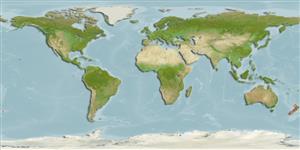Teleostei (teleosts) >
Gobiiformes (Gobies) >
Eleotridae (Bully sleepers)
Etymology: Gobiomorphus: Latin, gobius = gudgeon + Greek, morphe = shape (Ref. 45335).
Environment: milieu / climate zone / depth range / distribution range
Ecology
Marine; freshwater; brackish; demersal; amphidromous (Ref. 51243). Subtropical; 4°C - 22°C (Ref. 13614); 34°S - 47°S
Oceania: endemic to New Zealand.
Size / Weight / Age
Maturity: Lm ? range ? - ? cm
Max length : 15.0 cm TL male/unsexed; (Ref. 13614)
Occurs in various habitats such as small hypertrophic lakes, large oligotrophic lakes and lower reaches of rivers. Amphidromous (Ref. 11115). Feeds on a wide variety of benthic invertebrates.
Life cycle and mating behavior
Maturity | Reproduction | Spawning | Eggs | Fecundity | Larvae
McDowall, R.M., 1990. Freshwater fishes and fisheries of New Zealand -The angler's el dorado. Aquat. Sci. 2(2):281-341. (Ref. 11115)
IUCN Red List Status (Ref. 130435: Version 2024-2)
Threat to humans
Harmless
Human uses
Tools
Special reports
Download XML
Internet sources
Estimates based on models
Preferred temperature (Ref.
123201): 11.9 - 19.1, mean 16 °C (based on 116 cells).
Phylogenetic diversity index (Ref.
82804): PD
50 = 0.5020 [Uniqueness, from 0.5 = low to 2.0 = high].
Bayesian length-weight: a=0.00603 (0.00286 - 0.01269), b=3.10 (2.91 - 3.29), in cm total length, based on LWR estimates for this (Sub)family-body shape (Ref.
93245).
Trophic level (Ref.
69278): 3.3 ±0.1 se; based on diet studies.
Resilience (Ref.
120179): Medium, minimum population doubling time 1.4 - 4.4 years (Fec=200-2,000).
Fishing Vulnerability (Ref.
59153): Low vulnerability (10 of 100).
